
Q-weak Research Nabs Thesis Prize |
 During the 2013 Jefferson Lab Users Group annual meeting, Katherine Myers, Rutgers University, received the 2012 JSA Thesis Prize for her doctoral thesis, The First Determination of the Proton’s Weak Charge Through Parity-Violating Asymmetry Measurements. Here she is pictured with Hugh Montgomery, lab director and JSA president (from left); Jerry Draayer, JSA director; and Sebastian Kuhn, Users Group outgoing chair, Old Dominion University, after receiving the award. Research into the weak force turned out to be a strong topic for Katherine Myers' doctoral thesis, earning her the 2012 JSA Thesis Prize. Myers presented her thesis research and accepted the award at the Jefferson Lab Users Group Annual Meeting, held May 29-31. The prize is awarded for the best Ph.D. student thesis on research related to Jefferson Lab science and includes a $2,500 cash award and a commemorative plaque. "I definitely felt honored to receive the award, and maybe surprised. Of course, I would like to thank my advisers, Allena Opper at George Washington University and Dave Mack at Jefferson Lab, for helping me get involved in Q-weak and also helping me write a good dissertation," Myers says. "There are a lot of people at the lab to thank. It takes a lot of work to have an experiment run successfully." Myers' thesis describes her research into the weak force – one of the four fundamental forces in nature, along with gravity, and the electromagnetic and strong forces. She worked alongside other graduate students and scientists in the Q-weak collaboration to measure with what strength the weak force interacts with the proton. For her thesis, she analyzed data from the first two weeks of the experimental run...... more |
|
|
Users Meeting Packed With Awards, Research Results, Talks
|
Don’t Get Caught by the Spear Phisher’s Hook
|
JSA Awards Graduate Fellowships for Research at Lab
|
||
|
|
||||
Below the Fold: |
||||
|
|
||||
Q-weak Research Nabs Thesis Prize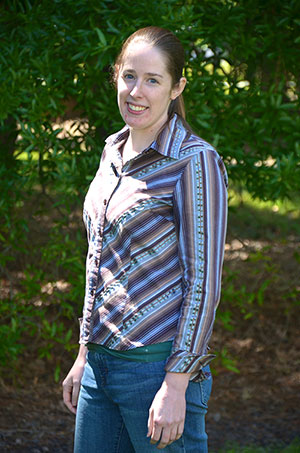 Katherine Myers, George Washington University, won the 2012 Jefferson Science Associates Thesis Prize for her doctoral thesis. Myers presented her thesis research at the Jefferson Lab Users Group Annual Meeting, held May 29-31. Research into the weak force turned out to be a strong topic for Katherine Myers' doctoral thesis, earning her the 2012 JSA Thesis Prize. Myers presented her thesis research and accepted the award at the Jefferson Lab Users Group Annual Meeting, held May 29-31. The prize is awarded for the best Ph.D. student thesis on research related to Jefferson Lab science and includes a $2,500 cash award and a commemorative plaque. "I definitely felt honored to receive the award, and maybe surprised. Of course, I would like to thank my advisers, Allena Opper at George Washington University and Dave Mack at Jefferson Lab, for helping me get involved in Q-weak and also helping me write a good dissertation," Myers says. "There are a lot of people at the lab to thank. It takes a lot of work to have an experiment run successfully." Myers' thesis describes her research into the weak force – one of the four fundamental forces in nature, along with gravity, and the electromagnetic and strong forces. She worked alongside other graduate students and scientists in the Q-weak collaboration to measure with what strength the weak force interacts with the proton. For her thesis, she analyzed data from the first two weeks of the experimental run. "It's something we haven't directly measured before. By doing this high-precision measurement, we get the weak charge of the proton. And, in the Standard Model, the proton's weak charge is expected to be very small," Myers says. While Q-weak is aimed at determining the weak charge of the proton, the fact that this number is expected to be small is very exciting for physicists. It's hoped that the precision measurement will uncover new information. "Doing a very precise measurement of a very small number gives us increased sensitivity to new physics. If there's some new physics signal in there, we'll be able to see it a little easier, because the Standard Model numbers are small," she explains. Myers wrote her thesis in pursuit of a Ph.D. in physics at George Washington University. The thesis, "The First Determination of the Proton's Weak Charge Through Parity-Violating Asymmetry Measurements in Elastic e+p and e+Al Scattering," was completed in February 2012. For the JSA prize, all submitted theses were judged on four key criteria by members of the Users Group board of directors: the quality of the written work, the student's contribution to the research, the work's impact on the field of physics and service (how the work benefits Jefferson Lab or other experiments). "Once again, the annual Thesis Prize competition attracted submissions of very high quality from eight former Ph.D. students at Jefferson Lab. As always, the UGBOD did a first round review, whittling this number down to three finalists. This was no easy task, since all submitted theses were worthy of recognition," says Sebastian Kuhn, former board chairman and a professor of physics and eminent scholar at Old Dominion University. "The prize winner was then selected from the three finalists by a committee of distinguished colleagues: M. Eric Christy (Hampton University, chair), Michael Pennington (Jefferson Lab) and Charles Hyde (Old Dominion University). We owe these committee members a great debt for their diligent work! Of course, we are also grateful to the Jefferson Science Associates programs committee and its Initiatives Fund for funding for this prize once again." In addition to her contributions to Q-weak, Myers served as the graduate student representative on the UGBOD, 2008-2010. This experience gave her a broader perspective on Jefferson Lab research, which she took into account when writing her thesis. "I think the thing that helps the most with writing a good thesis is already having done some technical writing. And if I were going to give advice, I'd tell graduate students to write technical reports on their work as they go along," she says. Myers is continuing to pursue a career in research. She is now a postdoctoral associate at Rutgers University and currently represents the interests of postdocs on the UGBOD. While she has continued to work in the Q-weak collaboration at Jefferson Lab, she is also now involved with other measurements of the proton, especially an effort to help solve the proton radius puzzle. Recent measurements of the actual size of the proton have provided conflicting results. The long-accepted value for the proton's size was determined through probes of the proton with electrons. But newer studies of the proton with subatomic particles called muons gave a different value for the proton's size. Myers and her colleagues aim to conduct a unique experiment that will measure the proton with both of these probes simultaneously. "My main focus now is on the MUSE experiment. What we're doing is measuring muon-proton and electron-proton scattering at the same time, so we can get the proton radius for both of those cases and see if they're the same or different from what the current situation suggests," she says. The MUSE, or Muon-Proton Scattering Experiment, will be carried out at the Paul Scherrer Institute in Switzerland. The JSA Thesis Prize was established in 1999 by the Southeastern Universities Research Association and is now one of many projects supported by the JSA Initiatives Fund Program. JSA is the management and operations contractor for Jefferson Lab. The Initiatives Fund Program supports efforts that further the scientific outreach and promote the science, education and technology missions of Jefferson Lab and the lab's user community. For more information about the JSA Initiatives Fund program, see: http://www.jsallc.org/IF/IFIndex.html By Kandice Carter |
||||
|
|
||||
Users Meeting Packed With Awards, Research Results, Talks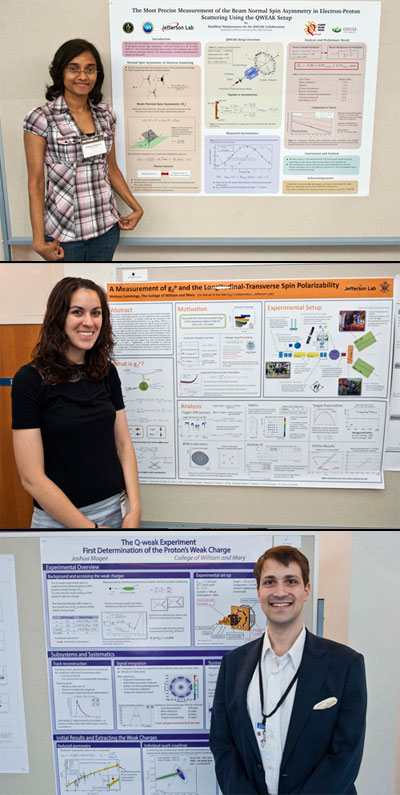 From the Top: Earning first place and receiving $1000 in the graduate student poster contest was Buddhini Waidyawansa, Ohio University. Receiving second place and earning $500 in the graduate student poster contest was Melissa Cummings, The College of William and Mary. Taking third place and receiving $250 in the graduate student poster contest was Joshua Magee, The College of William and Mary. The Jefferson Lab Users Group workshop and annual meeting was conducted at the lab, May 29-31. The agenda included the presentation of recent research results; updates from lab management regarding the lab’s budget and the status of the 12 GeV Upgrade program; briefings from representatives of the Department of Energy, Jefferson Science Associates/Southeastern Universities Research Association, the National Science Foundation and the Nuclear Science Advisory Committee; and the installation of the newest members of the Users Group Board of Directors. John Arrington, Argonne National Laboratory, became the new Users Group chair as Sebastian Kuhn, Old Dominion University, completed his tenure. The current board of directors is posted online at: https://wiki.jlab.org/cugwiki/index.php/UGBoD_Contact_Information Scientific talks were given by members of the JLab staff and Users community who had posted new research results. Talks also were given by physicists who were elected to fellowship by the American Physical Society in the last year and by a number of researchers who had received awards sponsored by JSA. Arrington; Elke Aschenauer, Brookhaven National Lab; Donal Day, University of Virginia; and Michelle Shinn, Jefferson Lab’s Free-Electron Laser Division, all elected to APS fellowship in 2012, gave talks. Paul Souder, Syracuse University, and Doug Beck, the University of Illinois, were recognized as the JSA Outstanding Nuclear Physicists of the year and Christopher Monahan, The College of William and Mary, was recognized as the JSA Postdoctoral Prize recipient. Katherine Myers, Rutgers University, was awarded the JSA Thesis Prize for her work, The First Determination of the Proton’s Weak Charge Through Parity-Violating Asymmetry Measurements. Another highlight was the graduate student poster contest which was held in conjunction with the reception at the end of the first day of the meeting. Nine graduate students submitted posters to the competition. Results of the competition are as follows: First Place: Buddhini Waidyawansa, Ohio University, with her poster, The Most Precise Measurement of the Beam Normal Spin Asymmetry in Electron-Proton Scattering Using the Q-weak Setup. Second Place: Melissa Cummings, The College of William and Mary, with her poster, A Measurement of the g2p and the Longitudinal-Transverse Spin Polarizability. Third Place: Joshua Magee, The College of William and Mary, with his poster, The Q-weak Experiment: First Determination of the Proton’s Weak Charge. This marked the seventh year for the poster contest. The first, second and third-place prize winners respectively received $1,000, $500 and $250. For judging the poster contest, 40 percent of the score was based on the poster itself (poster quality), 40 percent for the presentation given to the judges (command of subject matter) and 20 percent of the total score was based on the total impression made by both the poster and the presentation. Judges for the poster contest were Elton Smith, Jefferson Lab, and Steffen Strauch, University of South Carolina. These and other projects are funded by Jefferson Science Associates through the JSA Initiatives Fund Program, which was established in 2006 to support projects, initiatives and activities that further the scientific outreach and promote the science, education and technology missions of Jefferson Lab in ways that complement its basic and applied research focus. Initiatives Fund awards are for projects that benefit the Jefferson Lab users community and that leverage the commitments of others. The IF program is administered by SURA for the JSA Programs Committee. The Users Meeting ended with presentations discussing some of the research that will be able to take place at Jefferson Lab after 12 GeV Upgrade is completed. |
||||
|
|
||||
Don’t Get Caught by the Spear Phisher’s Hook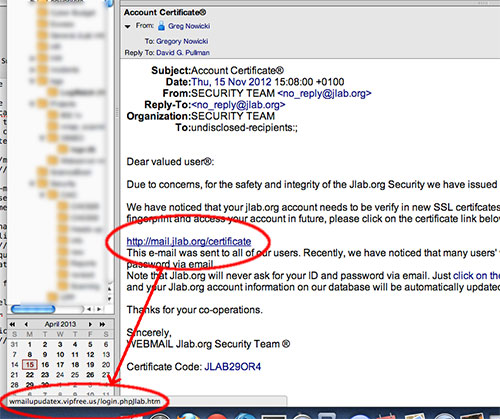 One way to authenticate a link embedded in an email is to hold your mouse over the web address without clicking. At the lower left of your email screen the actual web address it references will show up. If the addresses aren't the same, don't click on it, advises Greg Nowicki, cyber security manager. The phishers have gotten clever, very very clever, according to Jefferson Lab's Cyber Security Manager Greg Nowicki. It used to be that it was enough to send a generic, but intriguing email with a link for you to click and if you did, they had accomplished their mission. Now, as most people who use the Internet have learned, those links can mean someone's going to send you someplace you don't really want to go and, while you're there, they'll infect your computer. Experts call this targeted solicitation “spear phishing.” Here's how it works: say, for instance, you're going to be presenting at an upcoming conference and your name is on the conference website, along with your email address. The clever spear phisher, with cutting and pasting from the conference website, sends you an email that looks similar to something you might expect to receive from the organization. And so, of course, you click on the benign-looking link, and they're in. At the very least, you have been sent to a web address that will pay them money for your click. Worse, they've installed a virus on your computer and taken control of it or seized your email address book, from which they will send incrementally huge numbers of spam to your friends and colleagues. And Advanced Persistent Threats (APT) from hostile intruders are there seeking out intellectual property – looking to steal technological advances that will advance their own science in a single leap beyond their actual financial and knowledge-based resources. “And while we can have lots of defenses to protect our [cyber] perimeter,” Nowicki noted, “email has the ability to bypass those protections because we allow it in. And that's how they (phishers and spear phishers) can send infected files or malicious links to your JLab or personal email accounts. People tend to believe email.” Nowicki's message is clear: Do not trust email. One of the ways to authenticate that link you're about to click, no matter how real it seems, is to hold your mouse over the web address without clicking. At the lower left of your email screen, the actual web address it references will show up. If the addresses aren't the same, don't click on it. “Spammers have gotten really good at this,” he lamented. “It's up to each individual to do everything in their power to think first and check it out.” They’ve even been known to send emails that appear to be from the Jefferson Lab Help Desk. “We do not direct you off-site for anything to do with Jefferson Lab,” Nowicki warned, “and we never ask for your credentials (user name or password) on a non-JLab website. Period.” Everyone should report suspicious email by forwarding it to spam@jlab.org, which filters it and sends it directly to the Jefferson Lab Security Team. But suppose you've already clicked on or downloaded something and you're having second thoughts about it – what to do then? Report it immediately to security@jlab.org and explain what happened. The other strategy Nowicki suggests is to be diligent about downloading updates and patches for your system. The cyber world is ever-changing and programmers are doing their best to stay ahead of known threats. “If you keep your computer up to date on patches, it greatly diminishes the possibility that someone can get in,” he said. By Judi Tull |
||||
|
|
||||
JSA Awards Graduate Fellowships for Research at LabJefferson Sciences Associates has announced the award of seven JSA/Jefferson Lab graduate fellowships for the 2013-2014 academic year. The doctoral students will use the fellowships to support their advanced studies at their respective universities and to conduct research at Jefferson Lab. The students’ research proposals cover a broad scientific spectrum, including experimental and theoretical physics. JSA/JLab fellowship recipients attend universities that are members of the Southeastern Universities Research Association, a consortium of more than 60 research universities. The SURA Board of Trustees first established the fellowship program in 1989. Since the program’s inception, more than 170 fellowships have been awarded to students from 20 different SURA member universities. SURA built and operated Jefferson Lab, before becoming a partner of Jefferson Science Associates. The JSA/JLab Graduate Fellowship Program is now supported by the JSA Initiatives Fund. Each $12,000 fellowship award contributes to the student’s research assistant stipend and is matched by support from the home institution. An additional $2,000 is available for research-related travel for the student during the fellowship period. The committee that reviewed and selected this year’s fellowship recipients was chaired by JSA Board Director, Elizabeth Beise, from the University of Maryland. Other committee members included: Hari Areti, Jefferson Lab; Edward Brash, Christopher Newport University; Paul Eugenio, Florida State University; Jerry Gilfoyle, University of Richmond; George Lolos, University of Regina; and Zein-Eddine Meziani, Temple University. “We are pleased with the quality of the proposals submitted by students who are focused on the experimental and theoretical research programs at Jefferson Lab as they continue their coursework. The fellowship program provides opportunities for these young researchers to enhance their academic studies with direct experience with mentors and scientists at the lab,” said Beise. JSA President and Jefferson Lab Director, Hugh Montgomery, noted, “We are pleased that we continue to attract the best and brightest students in our field to spend time at Jefferson Lab. During the year, these young researchers will become fully immersed in their research and will tap into the unique capabilities of the lab. JSA’s continued support for the Graduate Fellowship Program has contributed to the lab’s achievement of producing about one-third of the U.S. Ph.D.’s in nuclear physics each year. Also, importantly, we are helping to educate and train the next generation of science leaders and increase science literacy in society and to advance knowledge of the structure of matter.” This news brief is extracted from the JSA news release, online at: http://www.jsallc.org/ |
||||
|
|
||||
Below the Fold: |
||||
Lab Earns Platinum Award for Continued Environmental Stewardship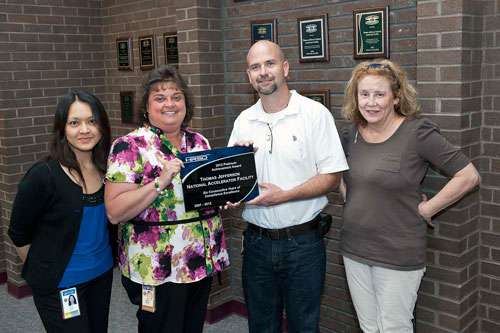 Jefferson Lab was among six businesses and agencies earning a 2012 Hampton Roads Sanitation District Platinum Achievement Award for perfect permit compliance for six consecutive years (2007-2012). Pictured with the award plaque are (left to right): Jeanine Leung, ESH&Q Division; Debra Brand, Facilities Management and Logistics; Scott Conley, ESH&Q Division; and Patty Hunt, Department of Energy’s Thomas Jefferson Site Office. Jefferson Lab was recognized for its continued high-levels of environmental stewardship in May by the Hampton Roads Sanitation District. The lab was among six businesses, industries and agencies earning a 2012 HRSD Platinum Achievement Award for perfect permit compliance for six consecutive years (2007-2012). The Hampton Roads Sanitation District General Manager, Ted Henifin, during the awards ceremony held in Norfolk said, “The businesses and industries we honor here have made an important investment in our region. Their demonstrated commitment to environmental protection helps HRSD ensure that future generations will inherit clean waterway and be able to keep them clean.” This recognition is a reflection of the Jefferson Lab community's continued commitment and dedicated execution of our pollution prevention and spill protection programs, according to Bill Rainey, JLab's Environmental, Safety and Health Department manager. "Permit compliance is a constant focus and this level of performance is only possible because the line organizations understand their critical role and take it seriously," he said. Contact Rainey, ext. 7898, or email wrainey@jlab.org, for information about the lab's Environmental Management System which include pollution prevention and spill protection activities and efforts. He would also like to be informed about improvements and advancements underway in these areas that could qualify for an HRSD or other award or recognition in the future. HRSD serves a population of 1.6 million in 17 cities and counties in southeastern Virginia. Its 13 treatment plants can handle up to 249 million gallons of wastewater every day. Retired Hall Leader Named Outstanding Referee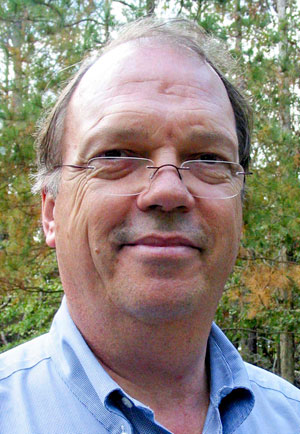 Kees de Jager, former Hall A leader, was named an Outstanding Referees of the Physical Review and Physical Review Letters journals for 2013. The American Physical Society named Kees de Jager, retired Hall A leader, one of the Outstanding Referees of the Physical Review and Physical Review Letters journals for 2013. He is among the 142 Outstanding Referees of the Physical Review and Physical Review Letters journals, as chosen by the journal editors for 2013. In email correspondence, Gene D. Sprouse, editor in chief of the American Physical Society, wrote, “Please allow me to congratulate you …on this honor, and thank you for your support and contributions to the APS journals and to the physics community.” The Outstanding Referee program was instituted in 2008 to recognize scientists who have been exceptionally helpful in assessing manuscripts for publication in the APS journals, according to an APS news release. By means of the program, APS expresses its appreciation to all referees, whose efforts in peer review not only keep the standards of the journals at a high level, but in many cases also help authors to improve the quality and readability of their articles – even those that are not published by APS. The highly selective Outstanding Referee program annually recognizes about 150 of the roughly 60,000 currently active referees. Like fellowship in the APS, this is a lifetime award. This year’s honorees come from more than 49 different countries, with large contingents from the U.S., Germany, Canada, Spain, United Kingdom and France. Award recipients receive a lapel pin and a certificate. A full listing of award recipients and more information about the program are available at: http://publish.aps.org/OutstandingReferees. Exploring the Universal GlueOur visible universe is built mostly of glue, which generates roughly 98 percent of visible mass. Now, an experiment is gearing up for Jefferson Lab’s newest experimental hall, Hall D, to study novel manifestations of that glue. Read more in a feature article by Kandice Carter that was published in the May issue of symmetry magazine and online at: http://www.symmetrymagazine.org/article/may-2013/exploring-the-universal-glue#sthash.rXo1c90c.dpuf Milestones for April – May 2013Hello Michael Brown; Industrial Hygiene Program Support Student; Environmental, Safety, Health & Quality Division Goodbye David Bryant, Information Technology Division These Milestone entries, listed alphabetically, are full-time, term, casual and student actions posted by Human Resources for April - May 2013. Jefferson Lab is currently seeking qualified individuals for more than a dozen positions, including scientific, engineering and technical positions. All current employment opportunities are posted at: http://www.resumeware.net/jlabs_rw/jlabs_web/job_search.cfm Information about career opportunities at Jefferson Lab is available at: https://www.jlab.org/job-openings Check Out JLab’s Video Glossary and Get Your ‘Physics Out Loud’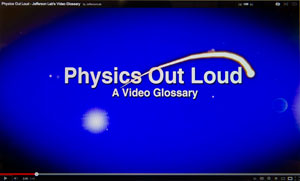 There’s a new way for budding scientists and anyone interested in learning more about nuclear physics to get help in deciphering some of the field's jargon-dense terminology Kandice Carter, Jefferson Lab science writer, in collaboration with several scientists at the lab, has developed and rolled out “Physics Out Loud” – Jefferson Lab’s video glossary. The first batch of completed videos debuted on the lab’s YouTube page in April. Since then, a total of 25 video glossary entries have been uploaded onto the webpage. Captioning is included on all of the videos. The average length of an entry is less than two minutes. This first season of “Physics Out Loud” covers a variety of topics, ranging from nuclear and elementary particles; exotic particles; forces; particle accelerators; accelerator technologies, components and materials; and lasers; to scientific principles; electron scattering; and particle-detection capabilities and devices. Terms explained include: It's hoped that the next season of Physics Out Loud will begin production in the winter. Send suggestions for possible new entries, as well as ideas for experts to feature, to Carter at: KCarter@jlab.org. The lab’s YouTube page is at: http://www.youtube.com/user/JeffersonLab/featured Jefferson Lab is also on Facebook, Twitter, flickr and Google+ JAG Dog Training Club Graduates New Class of Therapy Dogs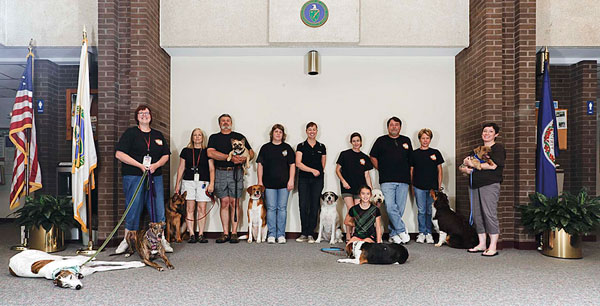 The 2013 JAG Dog Training Club pause for a group photo after a class. Kneeling in front is Sofia Keesee with Dana, a beagle. Standing (left to right) are Joyce Miller with Sammy and PG, greyhounds; Ingrid Kross with Regen, German shepherd; Brian Kross with Eddie, French bulldog; Sandi James with Ellie, Australian shepherd/German wirehaired pointer mix; Marie Keesee with Max, Australian labradoodle; Dave and Cappy Rackley with Sheldon, Australian shepherd; and Jen Monaghan with Shadow, Yorkshire terrier. The Jefferson Lab Activities Group Dog Training Club graduated its sixth class of therapy dogs on June 12, according to Joyce Miller, Dog Club captain. The latest class of Jefferson Lab therapy dogs will now be able to join graduates from previous classes in visiting people in hospitals, nursing homes, schools and libraries, where they do everything from lift spirits to providing an atmosphere that encourages children to relax and read. Evidence of positive responses to such animal-assisted therapy has mostly been anecdotal but a recent study by Virginia Commonwealth University has shown that workplace therapy dogs make a positive difference by reducing stress levels, according to Miller. Therapy dogs can be of any size and breed. Temperament is the key to being a good therapy dog in addition to being well trained, Miller explains. Therapy Dog International regularly receives requests for more or new therapy visits, so additional, trained dogs are always welcome, Miller points out. The JAG Dog Training Club is open to all lab employees, users, family members and their dogs. The club meets on Tuesday evenings at 7 p.m. in the Support Service Center lobby, Building 28. In addition to the therapy dog class, the dog training club also has held classes in agility skills, rally obedience, K-9 nosework and canine acting. |
||||
|
The On Target newsletter is published monthly by the Thomas Jefferson National Accelerator Facility (Jefferson Lab), a nuclear physics research laboratory in Newport News, Virginia, operated by Jefferson Science Associates, LLC, for the U.S. Department of Energy's Office of Science. Possible news items and ideas for future stories may be emailed to jlabinfo@jlab.org, or sent to the Jefferson Lab Public Affairs Office, Suite 15, 12000 Jefferson Avenue, Newport News, VA 23606
|
||||


 The Jefferson Lab Users Group workshop and annual meeting was conducted at the lab, May 29-31. The
The Jefferson Lab Users Group workshop and annual meeting was conducted at the lab, May 29-31. The  The phishers have gotten clever, very very clever, according to Jefferson Lab's Cyber Security Manager Greg Nowicki. It used to be that it was enough to send a generic, but intriguing email with a link for you to click and if you did, they had accomplished their mission.......
The phishers have gotten clever, very very clever, according to Jefferson Lab's Cyber Security Manager Greg Nowicki. It used to be that it was enough to send a generic, but intriguing email with a link for you to click and if you did, they had accomplished their mission.......  Jefferson Sciences Associates has announced the award of seven JSA/Jefferson Lab graduate
Jefferson Sciences Associates has announced the award of seven JSA/Jefferson Lab graduate